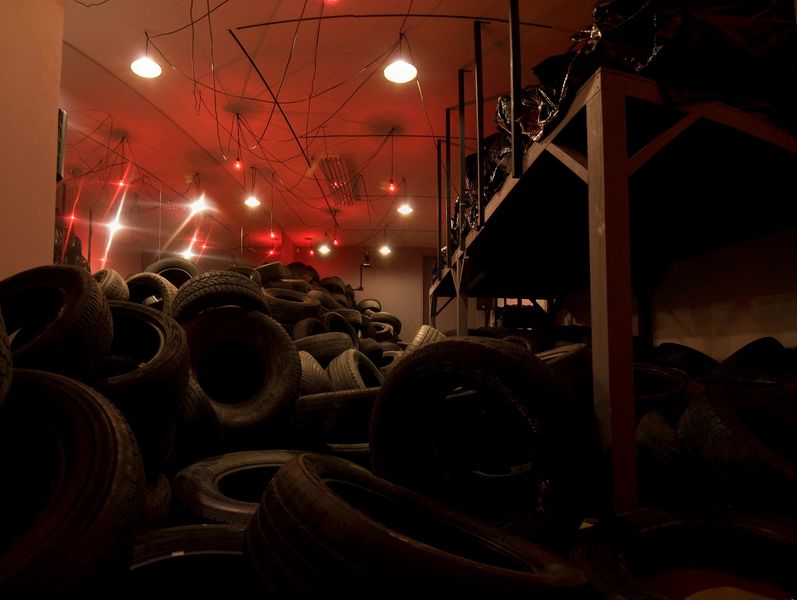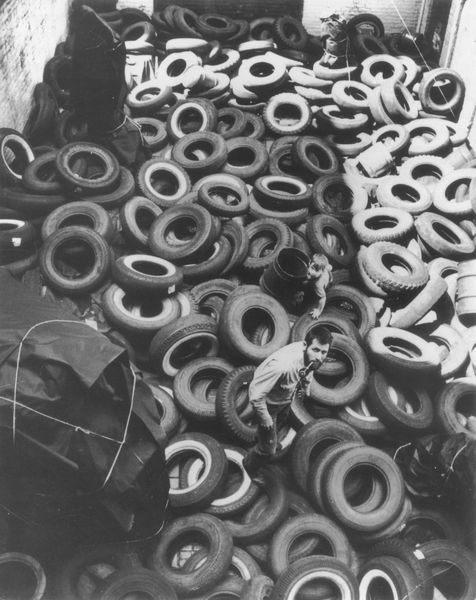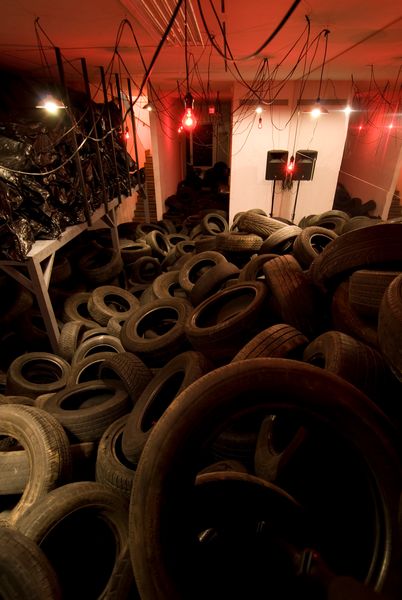Allan Kaprow: Yard

Allan Kaprow, Yard (To Harrow), 1961/2009 Reinvented by William Pope. L. Installation View,‘Allan Kaprow Yard’, Hauser & Wirth New York, 2009. © Allan Kaprow Estate. Courtesy Hauser and Wirth. Photo: Hannah Heinrich
Allan Kaprow: Yard
‘REARRANGE THE TIRES.’ The repeated command, its authority bolstered by the familiar-sounding intonations of an Obama impersonator, was part of the sound track for William Pope.L’s 2009 reinvention of Allan Kaprow’s 1961 ‘Yard’ – two proper names now attached to a pile of tires occupying the same town house on New York’s Upper East Side where the Martha Jackson Gallery hosted Kaprow’s original intrusion.
The first version of ‘Yard’ got its name from its outdoor location, in a courtyard that Kaprow filled with tires after covering over the modernist sculptures already on site. Many subsequent versions were to follow, adapted to changing circumstances. During his lifetime, Kaprow insisted on reconceiving his environments each time they were shown, reflecting his own evolving interests and occasionally putting him at odds with curators intent on presenting historical work.
Since his death in 2006, however, Kaprow’s tight hold on interpretation has given way to compound authorship. This multiplicity is emphasized by Helen Molesworth’s decision, as guest curator for this reinvention, to invite three separate voices, creating work for an equal number of sites, each in response to a different aspect of ‘Yard’s’ already manifold identity. Thus Pope.L’s tire-strewn interior was accompanied by two other new Yards: Josiah McElheny’s photographic projection at the Queens Museum of Art and Sharon Hayes’s intervention in the Lower East Side’s Marble Cemetery.
The original ‘Yard’s’ exterior site was built over long ago, and Pope.L’s ‘Yard’ was an entirely interior affair that turned the building’s first floor into an obstacle course of tires that rose to a climbable mound toward the rear. Viewers encountered a cavelike installation, the result of black plastic bags covering the street-side windows, and light emanating only from hanging red and white bulbs that switched on and off at disconcerting moments. Yet what registered even sooner was the smell of old rubber, issuing from piles of dirty tires whose rude presence was recorded but hardly conveyed in photographs of the original.
A presentation on the second floor of the gallery also documented Yard’s surprisingly long history, including, at one extreme, a 1991 version for Kaprow’s ‘7 Environments’ in Milan, where the chaotic pile of tires was replaced by orderly racks, in front of hot-pink walls, and the participatory element took the form of inviting viewers to change the tires of an immobilized Fiat. In Pope.L’s hands, however, Kaprow’s goal of breaking down boundaries between art and life took a decidedly macabre turn. Instead of wrapped sculptures, there were stacks of body bags in a rack along one wall – dismayingly lifelike (if one can say that in this context), with their cargo of mannequin parts and Vaseline, and disturbing to brush against, due to the oily residue on their surfaces.
‘Death is a big part of this whole thing,’ said Pope.L in a recent interview, referring not only to the body bags and the environmental decay evoked by the used tires but also to Kaprow’s absence, which precipitated the necessity for collaboration.

Allan Kaprow, Yard, 1961 © Ken Heyman-Woodfin CampCourtesy Research Library, The Getty Research Institute, Los Angeles, California (980063)
Early on, Kaprow speculated about whether, instead of transporting the tires to Manhattan, he might have taken his audience to the junkyard, and McElheny’s contribution played in the space between these two poles. Visitors to the Queens Museum were treated to a photographic experience of Willets Point, a nearby outpost of waste activity slated for eradication in favor of waterfront development.
McElheny’s cityscape, stitched together from aerial photos shot from a helicopter, was projected onto one of the walls surrounding the museum’s Panorama of the City of New York – a scale model of the five boroughs inherited from the 1964 World’s Fair and periodically updated to reflect the changing urban fabric. Willets Point was also the source for the used tires in Pope.L’s installation, which were rented for this purpose and therefore returnable (thus skirting a daunting disposal problem at the exhibition’s end).
Hayes was the only of the three artists to move decisively outside the confines of the gallery or museum. Marrying her engagement with the history of political sloganeering to the idea of the yard sign, she filled the relatively obscure Marble Cemetery with all manner of familiar textual flora, from election-campaign endorsements to sales announcements and trespass warnings. Hayes’s specific point of reference was a simple sketch by Kaprow of a signpost announcing Yard, but the textual overload could be connected to other aspects of his work, including the 1962 environment Words and his increasing desire to move beyond the gallery system.

Allan Kaprow, Yard (To Harrow), 1961/2009 Reinvented by William Pope. L. Installation View,‘Allan Kaprow Yard’, Hauser & Wirth New York, 2009 © Allan Kaprow Estate. Photo: Hannah Heinrich
Art history provides us with plenty of examples of pieces that have been interpreted differently over time, each era seeing the work in relation to an agenda shaped by its own needs and concerns. Here the work and the context have altered in concert, even as Yard continues to be identified with iconic photos of the 1961 installation.
The gallery that Hauser & Wirth has inaugurated in the same location as the pioneering Martha Jackson Gallery is part of an international operation, extending the reach of an institution already based in Zurich and London. Their representation of the Kaprow estate, along with a host of other blue-chip artists, both living and dead, reflects the paradoxical victory of an avant-garde now fully assimilated into a global art-world economy.
The long list of museums where versions of Yard appeared before circling back to its original location only confirms the work’s changed status. Nonetheless, there remains something unavoidably jarring about encountering a pile of tires in this setting, not least because they point to an everyday life suffused with ever greater awareness of their role in a toxic cycle of consumption and environmental destruction. Martha Buskirk teaches art history and criticism at Montserrat College of Art in Beverly, MA.
Related News
1 / 5




